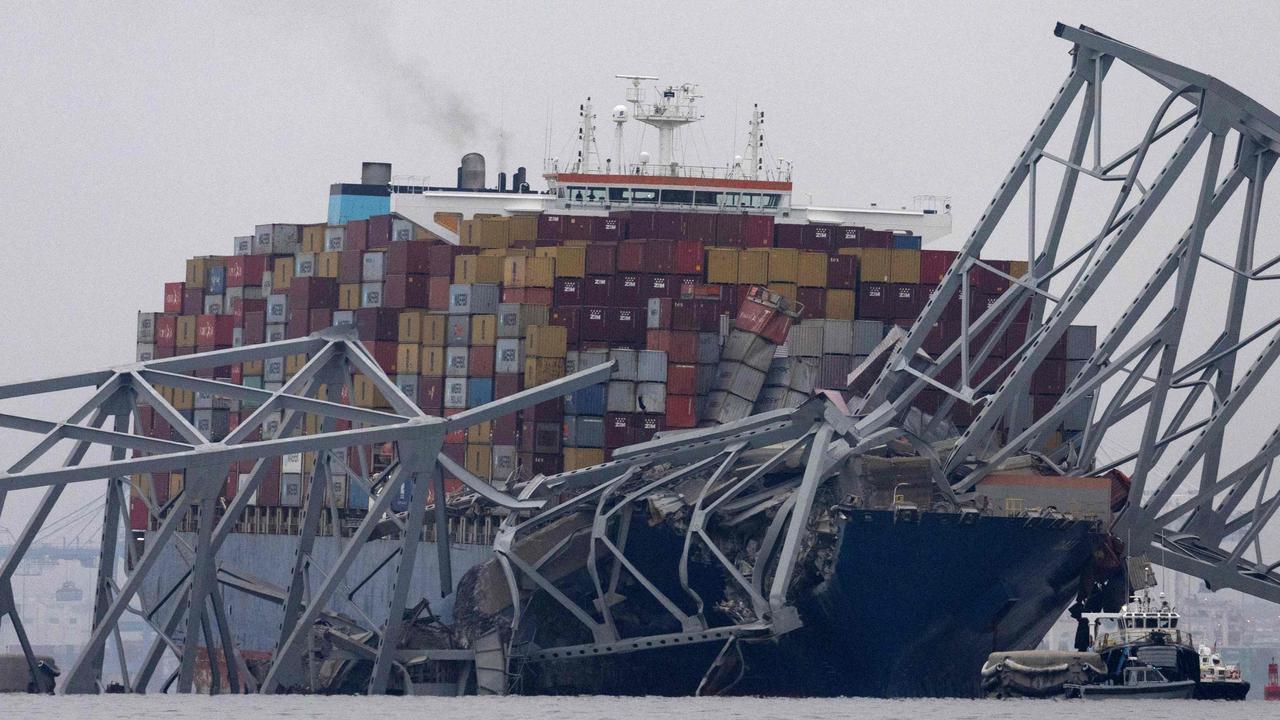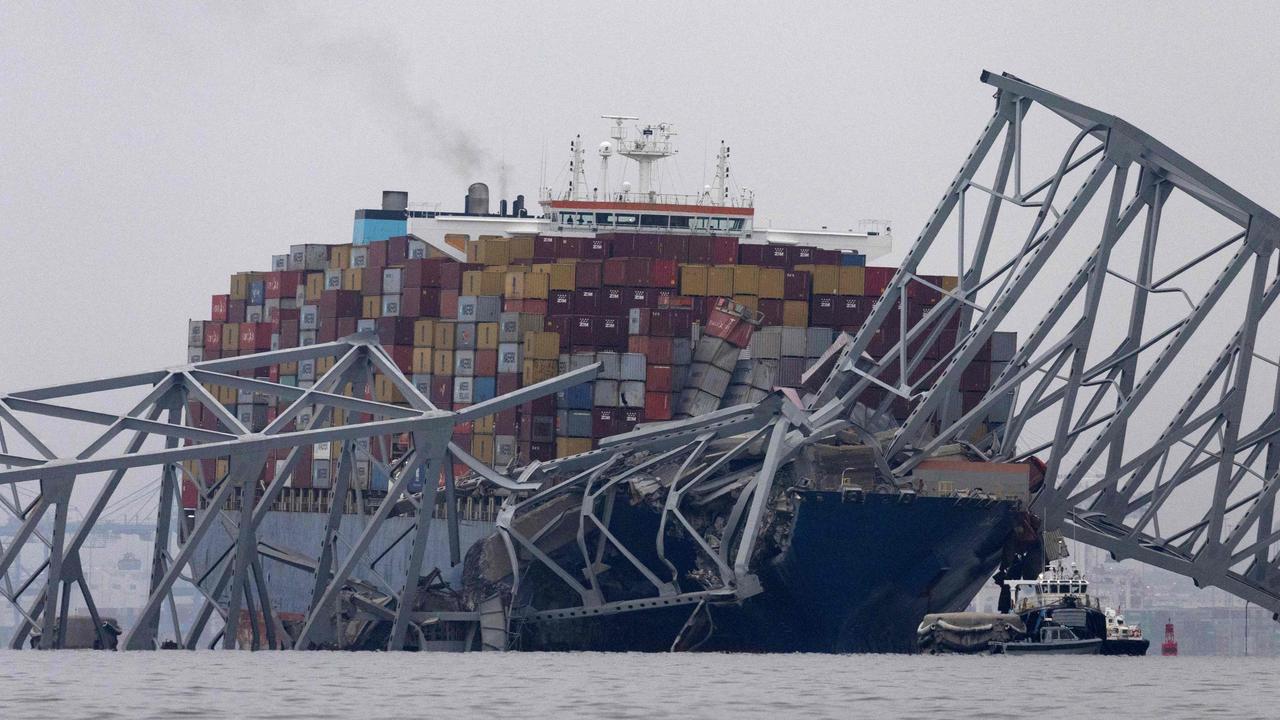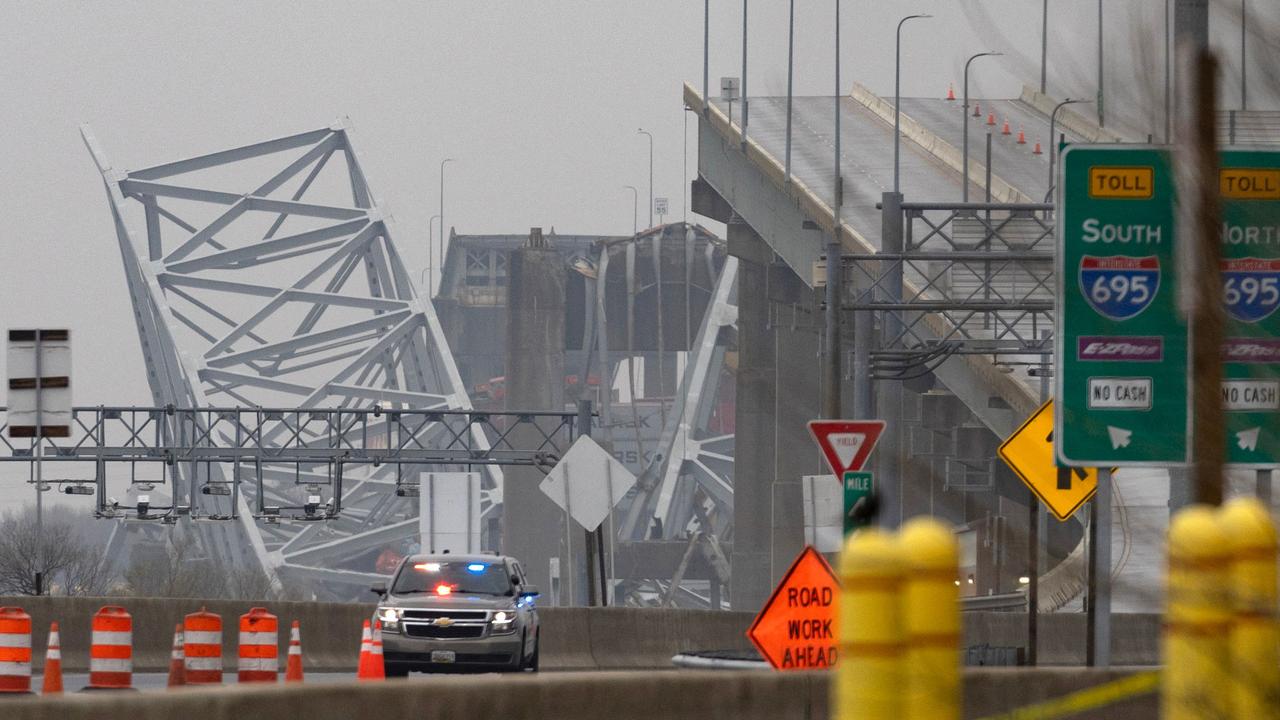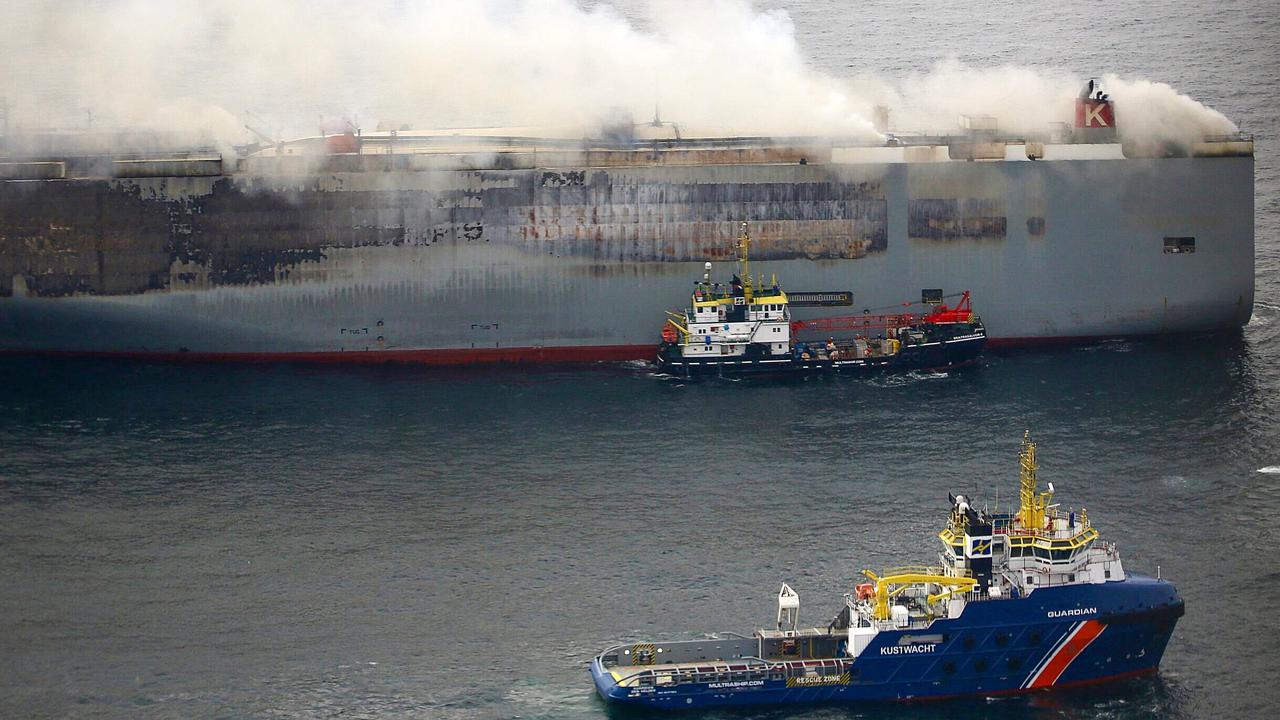Baltimore bridge collapse exposes ticking time bomb
Baltimore’s Francis Scott Key Bridge was destroyed by a cargo ship and the disaster has exposed a monstrous problem.

The ship that destroyed the Baltimore Bridge was big. Really big. But it is nowhere near the biggest. And that’s becoming a titanic problem.
It’s about economies of scale.
About 80 per cent of all global trade is carried by ocean-going vessels.
For Australia, that figure is 99.93 per cent.
“The shipping industry keeps making things more efficient — and thus more cost-effective and more attractive,” says Atlantic Council think-tank senior fellow Elisabeth Braw. “It’s thanks to shipping that it has made so much sense to build a globalised economy: It’s so cheap to ship goods globally that people in wealthy nations can have them made elsewhere, transported across a few oceans, and still pay less than if they were made at home.”

But the deaths of six people and the destruction of Baltimore’s Francis Scott Key Bridge after the containership MV Dali lost power this week has drawn attention to a growing problem.
Ship size.
“There is a push for efficiency and scale in the shipping industry, but this should not be allowed to give rise to unacceptable levels of risk,” Allianz Commercial senior marine risk consultant Andrew Kinsey said in a recent risk assessment.
“There have been welcome technical advances in shipping, but we do not yet see a commensurate safer environment.”
The equation is enticing.
A bigger ship doesn’t need many more crew than a big one. And a doubling in size only boosts the fuel bill by about 25 per cent.
That’s why it’s now about 80 per cent cheaper to carry 24,000 shipping containers on one monstrous vessel than the 250 needed to do the same in the 1960s.
But one drawback is becoming increasingly apparent: 10,000 shipping containers means a lot of eggs in one basket. And the newest ships carry 24,000 “eggs”.
That means each basket is getting incredibly heavy at 225,000 tonnes.
And – like the SS Titanic disaster of 1912 – there’s not a whole lot it can do to dodge an unexpected obstacle, such as a 250,000 tonne cruise ship carrying 5600 passengers.
Titans of commerce
“Since 2006, the average container ship has doubled in size to 4580 TEU (Twenty-foot Equivalent Unit – or a standard shipping container), and ships with a capacity of more than 12,000 TEU have accounted for 51 per cent of the fleet’s capacity expansion,” says Baltic and International Maritime Council (BIMCO) chief shipping analyst Niels Rasmussen.
“Today, just 626 ships provide 36 per cent of the fleet’s capacity, and the trend is set to continue as the large ships dominate the order book.”
Container ships traversing the Panama and Suez Canals are limited by the depth of the channels. Currently, ships can be weighed down no more than 44ft (13.4m) because of drought in Central America. Usually, it’s 50ft (15.2m).

This constrains the physical dimensions of any ship that desires passage. That, in turn, limits the number of shipping containers on each “Neo Panamax” class vessel to about 17,000.
For the open ocean, the only limitation is the size of the port receiving the ship.
They’ve been dubbed “Post Panamax” designs.
“We estimate that at the end of 2025 the average container ship will be larger than 5000 TEU, and the two (Neo Panamax and Post Panamax) segments will contribute more than 40 per cent of the fleet’s capacity,” said Rasmussen.
And the drive for efficiencies of scale continues.
Last year, the China State Shipbuilding Corporation (CSSC) announced plans to build a nuclear-powered 24,000 TEU “Post Panamax” container ship.
“The ultra-large nuclear container ship is designed to truly achieve ‘zero emissions’ during the ship’s operating cycle,” CSSC said in a statement released to Chinese social media.
Such a power source would also enable the vessel to move much faster than the usual 22 knots (41km/h).
That means much more momentum. And that brings added risk. Especially in the South China Sea and Singapore’s Strait of Malacca, the most congested – and accident-prone – regions for shipping worldwide.
Heavyweight haulers
“This week’s accident, which occurred when the container ship Dali lost power and headed straight into a support pillar, has delivered a reminder of the sheer overlooked scale of the shipping industry — and how unprepared many systems are to handle it,” says Braw.
The overall number of shipping accidents is steadily falling. But the average accident is getting more serious.
That’s the belief of the world’s shipping insurers.
The Allianz Commercial Safety and Shipping Review found there were almost 2000 reported incidents of ships colliding with port infrastructure (harbour walls, piers, cranes) over the past decade. These mainly involved piers and harbour walls. About 200 of these involved container ships.
And the electrical failure aboard MV Dali is nothing out of the ordinary.
The Allianz report says machinery failure was behind almost half the global shipping accidents between 2013 and 2022.

What is new is the increasing size and weight of the ships experiencing such failures. And the impact these ships have on infrastructure often originally designed to handle less than a quarter of their weight.
Baltimore’s Francois Scott Key Bridge was opened in 1977.
It was an era when the newest and largest “Panamax” container ships carried about 3300 standardised steel boxes. They weighed about 53,000 tonnes.
The Baltimore bridge was not built to withstand a collision with one of those. Or any other ship, for that matter.
However, after a collision that collapsed the Sunshine Skyway Bridge in Florida’s Tampa Bay in 1980, new bridges were generally built with pylon, sand, and rubble “dolphins” (barriers) around reinforced and deeper foundations.
This idea was not conceived with the 95,000 ton, 300m long MV Dali – almost as big as a US Navy nuclear-powered aircraft carrier – in mind.
And the newest and largest container ships entering service in 2024 are 400m long, 61m wide and can carry some 24,000 shipping containers.
They can weigh over 225,000 tonnes.
Worst case scenario
“Insurers such as AGCS have been warning for years that the increasing size of vessels is leading to a higher accumulation of risk,” explains Allianz’s Captain Khanna. “These fears are now being realised, as demonstrated by the growing number, and cost, of incidents.”
Bridge collisions were low on international shipping insurers’ radars until this week.
The main fear was fire, which caused the loss of 64 ships in the five years to 2022.
“Hazardous and combustible goods are increasingly transported by containers, while the prevalence of Lithium-ion (Li-ion) batteries poses a growing risk for both container shipping and car carrier vessels,” the Allianz report states. “At the same time, these hazardous cargoes are increasingly transported by large vessels, where the consequences of fires are amplified, resulting in more severe losses and longer delays.”

Such a fire can rapidly expand far beyond the capacity of a crew of 20 to 30 to handle, it adds.
And that’s why most of the world’s shipping lines quickly diverted from the Red Sea amid drone and missile attacks from Houthi rebels.
“The cost of casualties or incidents is rising, with an increase in severity, and this is down to the increasing size of vessels,” says Khanna. “Such ships generate economies of scale for ship owners but also increased risk, and a disproportionately greater cost when things go wrong.”
The Allianz report details its “worst case scenario”, a collision between a container ship and a cruise liner.
That’s a 225,000-tonne “Post Panamax” container ship and a modern 250,000-tonne cruise liner carrying some 5600 passengers.
Few harbours can receive them. Even fewer can provide the emergency services needed to support them.
“Larger vessels mean larger losses,” says Khanna. “An incident involving a workaday (average) container ship or car carrier … can now cost as much as $US1bn, once salvage and environmental considerations are factored in. A major incident involving two mega container/passenger vessels in an environmentally-sensitive region could cost in excess of $US4bn.”






